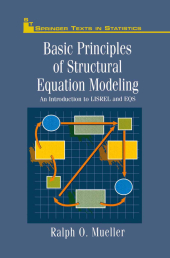 Neuerscheinungen 2011Stand: 2020-01-07 |
Schnellsuche
ISBN/Stichwort/Autor
|
Herderstraße 10
10625 Berlin
Tel.: 030 315 714 16
Fax 030 315 714 14
info@buchspektrum.de |

Ralph O. Mueller
Basic Principles of Structural Equation Modeling
An Introduction to LISREL and EQS
2011. xxviii, 232 S. 55 Tabellen. 235 mm
Verlag/Jahr: SPRINGER, BERLIN 2011
ISBN: 1-461-28455-4 (1461284554)
Neue ISBN: 978-1-461-28455-0 (9781461284550)
Preis und Lieferzeit: Bitte klicken
During the last two decades, structural equation modeling (SEM) has emerged as a powerful multivariate data analysis tool in social science research settings, especially in the fields of sociology, psychology, and education. Although its roots can be traced back to the first half of this century, when Spearman (1904) developed factor analysis and Wright (1934) introduced path analysis, it was not until the 1970s that the works by Karl Joreskog and his associates (e. g. , Joreskog, 1977; Joreskog and Van Thillo, 1973) began to make general SEM techniques accessible to the social and behavioral science research communities. Today, with the development and increasing avail ability of SEM computer programs, SEM has become a well-established and respected data analysis method, incorporating many of the traditional analysis techniques as special cases. State-of-the-art SEM software packages such as LISREL (Joreskog and Sorbom, 1993a,b) and EQS (Bentler, 1993; Bentler and Wu, 1993) handle a variety of ordinary least squares regression designs as well as complex structural equation models involving variables with arbitrary distributions. Unfortunately, many students and researchers hesitate to use SEM methods, perhaps due to the somewhat complex underlying statistical repre sentation and theory. In my opinion, social science students and researchers can benefit greatly from acquiring knowledge and skills in SEM since the methods-applied appropriately-can provide a bridge between the theo retical and empirical aspects of behavioral research.
Contents:
Preface
Frequently Used Symbols and Notation
List of Figures and Tables
CHAPTER 1: Linear Regression and Classical Path Analysis
Overview and Key Points.
Linear Ordinary Least Squares Regression.
Classical Path Analysis.
Summary. Exercises. Recommended Readings.
CHAPTER 2: Confirmatory Factor Analysis.
Overview and Key Points.
Specification and Identification of a CFA Model.
Data-Model Fit.
Model Modification.
Validity and Reliability from a CFA Perspective.
Summary. Exercises. Recommended Readings.
CHAPTER 3: General Structural Equation Modeling.
Overview and Key Points.
Specification and Identification of a General Structural Equation Model.
The Direct, Indirect, and Total Structural Effect Components.
Parameter Estimation.
The Structural Equation Modeling Process: An Illustrated Review and Summary.
Conclusion. Exercises. Recommended Readings.
APPENDIX A: The Simplis Command Language.
APPENDIX B: Location, Dispersion and Association.
APPENDIX C: Matrix Algebra
APPENDIX D: Descriptive Statistics for the SES Analysis.
APPENDIX E: Descriptive Statistics for the HBI Analysis.
References. Index.


